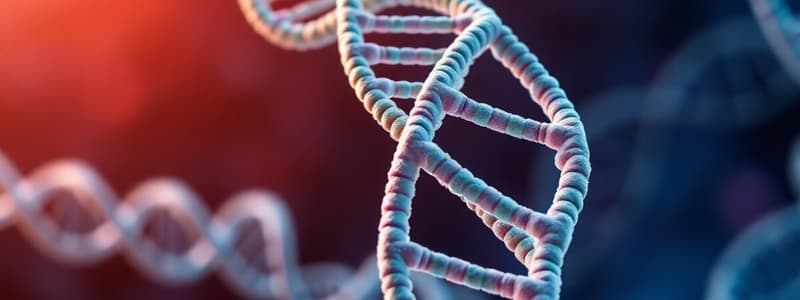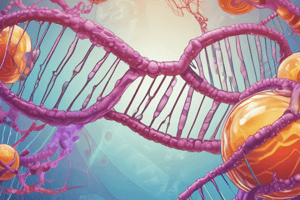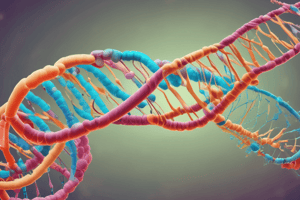Podcast
Questions and Answers
What role does GIn 29 play in the DNA binding mechanism of the HTH motif?
What role does GIn 29 play in the DNA binding mechanism of the HTH motif?
- It reduces the number of hydrogen bonds formed.
- It is critical for specificity as it interacts with two base pairs. (correct)
- It initiates the binding of the HTH motif to the DNA.
- It enhances the overall protein stability.
How do palindromic operator regions contribute to protein binding in the context of DNA?
How do palindromic operator regions contribute to protein binding in the context of DNA?
- They allow for variable protein binding across different sequences.
- They inhibit protein binding due to steric hindrance.
- They facilitate effective binding by allowing each subunit to bind to identical halves. (correct)
- They enable binding to only one half of the palindrome.
Which of the following is true regarding the interaction between residues of the recognition α-helix and DNA base pairs?
Which of the following is true regarding the interaction between residues of the recognition α-helix and DNA base pairs?
- Base pairs do not influence the effectiveness of protein binding.
- Only the first base pair is recognized by the α-helix residues.
- Residue interactions include hydrogen bonds and can involve methyl group interactions. (correct)
- Residue interactions are solely dependent on electrostatic forces.
What is the primary function of the lambda repressor protein in a genetic context?
What is the primary function of the lambda repressor protein in a genetic context?
In the context of dimer formation in DNA-binding proteins, what is a key characteristic of the HTH motif?
In the context of dimer formation in DNA-binding proteins, what is a key characteristic of the HTH motif?
What is the primary function of the C-terminal domain of the lambda repressor protein?
What is the primary function of the C-terminal domain of the lambda repressor protein?
Which structural feature is fundamental for the lambda repressor's binding to DNA?
Which structural feature is fundamental for the lambda repressor's binding to DNA?
What occurs when UV light affects the lambda repressor dimer?
What occurs when UV light affects the lambda repressor dimer?
How many α-helices are connected by loops in the N-terminal domain of the repressor subunit?
How many α-helices are connected by loops in the N-terminal domain of the repressor subunit?
What is the role of the helix-turn-helix motif in DNA recognition?
What is the role of the helix-turn-helix motif in DNA recognition?
What happens to the lambda repressor protein upon dimer formation?
What happens to the lambda repressor protein upon dimer formation?
In the helix-turn-helix motif, what separates the recognition α-helices?
In the helix-turn-helix motif, what separates the recognition α-helices?
Which characteristic of the lambda repressor protein suggests its role in gene regulation?
Which characteristic of the lambda repressor protein suggests its role in gene regulation?
What is the role of base pairs in the interaction between a repressor and its operator?
What is the role of base pairs in the interaction between a repressor and its operator?
How does the kink at base pair 2 affect the palindromic major groove?
How does the kink at base pair 2 affect the palindromic major groove?
Which of the following describes the structural feature of the recognition interface?
Which of the following describes the structural feature of the recognition interface?
What stabilizes the unstacking of the DNA base pairs?
What stabilizes the unstacking of the DNA base pairs?
What occurs due to bending of base pairs 3-6 in the interaction with TetR?
What occurs due to bending of base pairs 3-6 in the interaction with TetR?
What is a key characteristic of the DNA-protein interface in this interaction?
What is a key characteristic of the DNA-protein interface in this interaction?
What type of motif is involved in the binding of the DNA-binding domain of TetR?
What type of motif is involved in the binding of the DNA-binding domain of TetR?
What is the consequence of no overall DNA-bending in the studied interaction?
What is the consequence of no overall DNA-bending in the studied interaction?
Flashcards
HTH Motif DNA Binding
HTH Motif DNA Binding
HTH motifs bind to specific DNA sequences, often palindromes, by interacting with DNA base pairs.
Palindromic Operator Regions
Palindromic Operator Regions
DNA sequences that read the same forward and backward, facilitating strong protein binding.
Base Pair Recognition
Base Pair Recognition
Specific amino acids in the protein interact with particular bases in the DNA sequence.
Q28 and Q29 Interaction with Base Pairs
Q28 and Q29 Interaction with Base Pairs
Signup and view all the flashcards
Specificity in Q29
Specificity in Q29
Signup and view all the flashcards
TetR-tetO Interaction
TetR-tetO Interaction
Signup and view all the flashcards
Palindromic tetO
Palindromic tetO
Signup and view all the flashcards
Base Pair 2 Kink
Base Pair 2 Kink
Signup and view all the flashcards
Hydrogen Bonds for Specificity
Hydrogen Bonds for Specificity
Signup and view all the flashcards
G2-Arg28 and A3-Gln38 Interactions
G2-Arg28 and A3-Gln38 Interactions
Signup and view all the flashcards
Base Pair Bending
Base Pair Bending
Signup and view all the flashcards
No DNA Bending
No DNA Bending
Signup and view all the flashcards
High Structural Complementarity
High Structural Complementarity
Signup and view all the flashcards
Lambda Repressor Subunit
Lambda Repressor Subunit
Signup and view all the flashcards
Helix-Turn-Helix Motif
Helix-Turn-Helix Motif
Signup and view all the flashcards
Recognition Helix
Recognition Helix
Signup and view all the flashcards
Stabilization Helix
Stabilization Helix
Signup and view all the flashcards
How do Lambda Repressor Subunits Dimerize?
How do Lambda Repressor Subunits Dimerize?
Signup and view all the flashcards
What is the effect of UV light on the Lambda Repressor?
What is the effect of UV light on the Lambda Repressor?
Signup and view all the flashcards
How does the Lambda Repressor regulate gene expression?
How does the Lambda Repressor regulate gene expression?
Signup and view all the flashcards
Distance between Recognition Helices
Distance between Recognition Helices
Signup and view all the flashcards
Study Notes
Prokaryotic DNA-binding Proteins
- Prokaryotic DNA-binding proteins are key regulators of gene expression
- These proteins recognize specific DNA sequences to control gene activity
- Structural motifs like helix-turn-helix (HTH) enable DNA binding
- The lambda phage genetic switch serves as a model for DNA recognition
DNA Recognition in Procaryotes by Helix-Turn-Helix Motifs
- The helix-turn-helix (HTH) motif is a protein structure consisting of two α-helices connected by a short β-turn
- The recognition helix binds in the major groove of B-DNA
- The stability helix stabilizes the motif's interaction with DNA
- Recognition α-helices of subunits are separated by 34Å
- Recognition α-helices bind in the major groove of the DNA
DNA Binding Mechanism of the HTH Motif
- Palindromic operator regions allow effective protein binding
- Each subunit binds to almost identical halves of the palindrome
- Identical bases in the first three base pairs create a general recognition site for operators
- Residues of recognition α-helix interact with DNA base pairs
- Different base pairs (e.g., T14'-A1), have particular amino acid interactions (e.g., hydrogen bond of Gln 28 with adenine)
- Gln 29 is essential for sequence specificity
Differential DNA Binding by Repressor and Cro Proteins
- Protein-DNA interactions determine DNA conformation
- Binding of protein dimer induces structural changes in B-DNA
- DNA sugar-phosphate interactions stabilize these changes
- Protein subunits anchor to the major groove through hydrogen bonds with DNA phosphate groups
- Protein loops extend into the minor groove, creating additional contacts with phosphates
- Repressor prefers A-T base pairs; Cro is indifferent
- Sequence of central base pairs influences interactions
- A-T pairs fit better in the narrowed minor groove
HTH Motifs in Prokaryotes
- Lac repressor molecule binds into two successive major grooves of DNA
- The CAP-cyclic AMP-DNA complex illustrates HTH motif binding in prokaryotes
Take Home Messages (DNA Recognition in Prokaryotes by Helix-Turn-Helix Motifs)
- The helix-turn-helix motif includes a recognition helix and a stability helix connected by a short turn
- Subunit interactions ensure the appropriate distance and orientation for binding
- Sequence-specific interaction between the recognition helix and DNA facilitate identification of the palindromic operator region
- Hydrogen bonds between sugar-phosphate backbone and protein and DNA distortion facilitate close interaction between regions and DNA-binding proteins
Take Home Messages (Tetracycline-induced gene expression)
- Tetracycline induces expression of tetA by binding to and changing TetR conformation
- TetR is a homodimer with two domains (HTH-motif and regulatory domain)
- TetR-teto interactions are sequence-specific and have high structural complementarity
- TetR and teto interactions involve hydrogen bonds.
- No overall DNA bending, kink at base pair 2 is compensated
Induction by Tetracycline and Mg2+
- Conformational changes throughout the entire protein occur due to tetracycline (or Mg2+) binding
- Mg2+ displaces certain amino acid residues
- Whole a6 helix shifts due to conformational change
Comparison of TetR to Lacl
- Both TetR and Lacl are DNA-binding proteins that control gene expression
- Similarities include dimeric nature; HTH-motif; DNA-binding and inducer-binding domains
- Differences include TetR’s conformational changes upon induction, kink; Lacl’s distinct DNA bending upon induction
Structure of TetR
- TetR is a homodimer
- It has 10 α-helices per polypeptide chain
- TetR has two separate domains, DNA-binding and regulatory domain
- [MgTc]+ binding pocket in the regulatory domain
Sequence Specific Interactions
- All base pairs (except 0) contribute to the sequence-specific interactions between repressor and operator
- Each HTH-motif binds the major groove of the palindromic half-operator
Studying That Suits You
Use AI to generate personalized quizzes and flashcards to suit your learning preferences.




